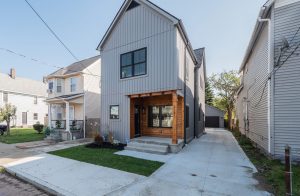
Cuyahoga Land Bank is deeply committed to revitalizing older neighborhoods and inner-ring suburbs that have historically experienced limited new home development. Our approach centers on a strategic investment model designed to spark broader market interest and create sustainable growth. As Jennifer Vazquez-Norman, Director of Real Estate Development at the Land Bank, explains, “Because of our unique expertise and the tools at our disposal, the Land Bank can strategically invest in neighborhoods to act as a catalyst, demonstrating potential and paving the way for private developers to thrive, ultimately leading to lasting neighborhood revitalization.” This Q&A with Dennis Roberts, the Land Bank’s Chief Strategy Officer, delves into the Land Bank’s strategy and explores how it’s successfully attracting private investment to these vital areas.
What is the Land Bank’s overall strategy about building and renovating homes in older neighborhoods and inner-ring suburbs that don’t typically experience new home development?
Cuyahoga Land Bank’s strategy is to invest in “tipping point” neighborhoods, those that with the Land Bank’s strategic initial investment can have a subsequent increase in private investment.
The cost of new construction and renovations in these neighborhoods is generally higher than what can be recovered from a potential sale because of limited development activity and/or an appraisal gap. So the Land Bank usually takes a loss on the home, but sets the value of what homes can be sold for in the neighborhood, which can help tip a neighborhood into being a desirable place to buy and build homes.
The Land Bank is often positioned as the “loss leader.” As we continue to build and renovate homes in a given area either on our own or through strategic partnerships, we continue to increase sale prices and market value for nearby properties and thereby decrease the amount of loss or subsidy needed there over time.
Beyond partnering with developers for private market development, we repair nearby homes and leverage neighborhood beautification programs, so that everyone in the community can feel the value of the Land Bank’s investment. As the market improves in an area, the Land Bank exits and then begins similar work in a different tipping point neighborhood.
Has this strategy catalyzed investment from private developers?
Most recently, near Clark and Rowley Avenues on the edge of the Clark-Fulton neighborhood, we acquired vacant nuisance properties in the area, demolished those as needed and then began construction of three single family homes. These were the first newly constructed homes in this area in quite a while. After they sold, we entered a joint venture with developer Steve Goldberg for two additional homes. Goldberg’s homes sold quickly at the top of the market, improving upon the Land Bank’s previous sale prices.
We just began our final phases of new construction in this area, which include market rate and affordable products. Further, we have recently seen new renovations come up for sale nearby. These renovations likely would not have been feasible for private market developers (or even homeowners who can now see the benefit of investing in their homes) without subsidy if not for the Land Bank’s initial investment.
How did the three new homes you built attract Goldberg’s interest?
We got involved with Steve after we completed and sold our first three homes in the Clark-Rowley area. He saw the investment that we made and believed he could use the value we created to build and sell homes with limited subsidy or assistance from the Land Bank.
How many homes did Steve build in the Clark-Rowley neighborhood and how did you work with Steve on his development?
Steve built two homes that sold quickly in the neighborhood following the Land Bank’s first three, all of which were also sought after with high demand. Our initial investment in the community is successfully spurring private development in this tipping point area.

